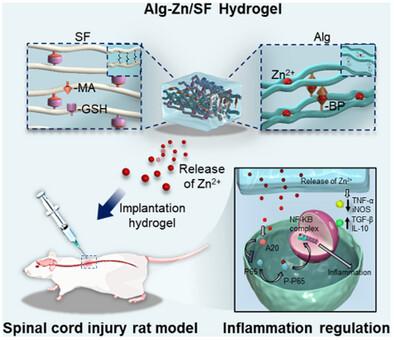Zinc-Directed Coordination Network Hydrogels for A20-Mediated Inflammation Modulation and Enhanced Axonal Regeneration in Spinal Cord Injury
IF 18.5
1区 材料科学
Q1 CHEMISTRY, MULTIDISCIPLINARY
引用次数: 0
Abstract
Remodeling the adaptive microenvironment with biomaterials presents a promising avenue for addressing chronic inflammation that contributes to spinal cord injury (SCI) repair. Hydrogels have been widely employed to enhance tissue regeneration following SCI. Additionally, zinc (Zn) ions are effective in immune modulation for the central nervous system. However, significant challenges remain in preparing hydrogels combining bioactive Zn2+ with biological functionality for traumatic SCI repair. In this study, a self-healing hydrogel composed of an alginate network based on dynamic Zn2+/bisphosphonate (BP) cross–linking, and a silk fibroin interpenetrating polymer network is reported. It is observed that the neurite outgrowth is promoted by Zn2+ and shows dependency on Zn2+ concentration. Moreover, the Zn2+-releasing hydrogel enhances neuronal axon growth and influences neural stem cell proliferation and differentiation. In addition, the hydrogel regulates microglial cell fate by upregulating the anti-inflammatory signaling molecule A20 through inhibition of the NF-κB pathway. Therefore, this hydrogel effectively improves immune response modulation while promoting neural regeneration and functional recovery, including motor, sensory, and bladder function in completely transected SCI. These results indicate the Zn2+/BP-based hydrogel holds the potential for traumatic SCI treatment.

锌定向配位网络水凝胶用于a20介导的炎症调节和增强脊髓损伤轴突再生
用生物材料重塑适应性微环境是解决慢性炎症有助于脊髓损伤(SCI)修复的一个有希望的途径。水凝胶已被广泛用于促进脊髓损伤后的组织再生。此外,锌离子在中枢神经系统的免疫调节中是有效的。然而,在制备将生物活性Zn2+与生物功能相结合的水凝胶用于创伤性脊髓损伤修复方面仍然存在重大挑战。本研究报道了一种由动态Zn2+/双膦酸盐(BP)交联的海藻酸盐网络和丝素互穿聚合物网络组成的自愈水凝胶。观察到,Zn2+促进了神经突的生长,并与Zn2+浓度有关。此外,释放Zn2+的水凝胶可以促进神经轴突生长,影响神经干细胞的增殖和分化。此外,水凝胶通过抑制NF-κB通路上调抗炎信号分子A20来调节小胶质细胞的命运。因此,该水凝胶有效改善免疫反应调节,同时促进神经再生和功能恢复,包括运动、感觉和膀胱功能。这些结果表明,基于Zn2+/ bp的水凝胶具有创伤性脊髓损伤治疗的潜力。
本文章由计算机程序翻译,如有差异,请以英文原文为准。
求助全文
约1分钟内获得全文
求助全文
来源期刊

Advanced Functional Materials
工程技术-材料科学:综合
CiteScore
29.50
自引率
4.20%
发文量
2086
审稿时长
2.1 months
期刊介绍:
Firmly established as a top-tier materials science journal, Advanced Functional Materials reports breakthrough research in all aspects of materials science, including nanotechnology, chemistry, physics, and biology every week.
Advanced Functional Materials is known for its rapid and fair peer review, quality content, and high impact, making it the first choice of the international materials science community.
 求助内容:
求助内容: 应助结果提醒方式:
应助结果提醒方式:


